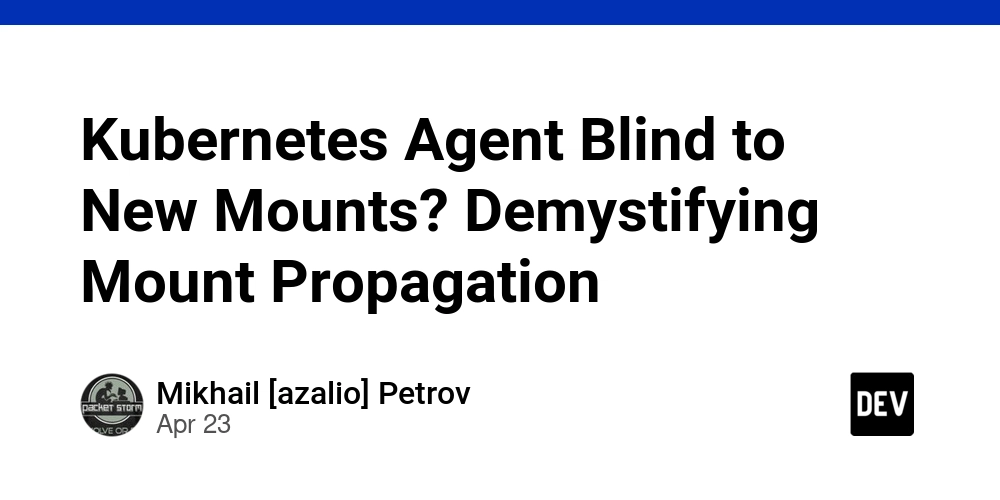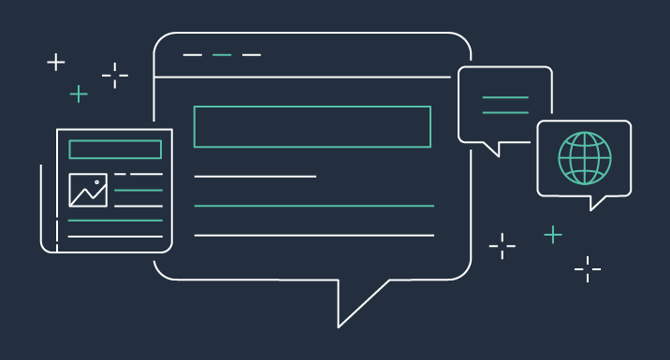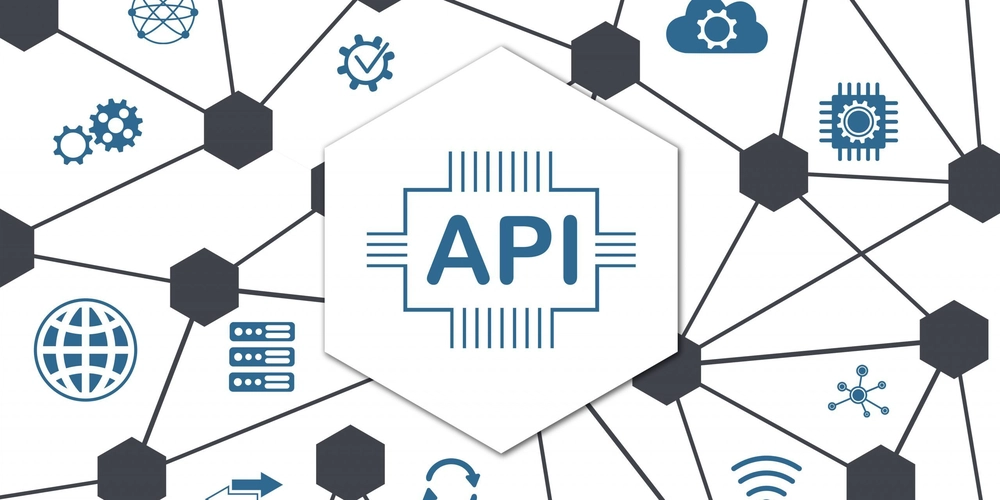Devops News
Dev
239

Image Credit: Dev
Kubernetes Agent Blind to New Mounts? Demystifying Mount Propagation
- The article discusses how Kubernetes mountPropagation: HostToContainer leverages Linux namespaces to address the issue of agents being blind to new mounts created by Kubelet.
- By default, each container in Kubernetes has its own isolated mount namespace, which causes the 'blind agent' problem when new mounts are not automatically reflected inside the container.
- Kubernetes provides the mountPropagation field with modes like None, HostToContainer, and Bidirectional to control the sharing of mount events between the host and container's namespace.
- To fix the blind agent issue, setting mountPropagation to HostToContainer allows the agent to see new PVs mounted by Kubelet without requiring a restart.
- When mountPropagation is set to HostToContainer, any mount events occurring under the host path are automatically propagated into the container's mount namespace.
- Considerations include security implications of Bidirectional mode and the need for appropriate privileges if the agent performs actions within the propagated mounts.
- For troubleshooting, checking the mount table inside the container and comparing it to the host's can help identify issues related to mount propagation.
- Understanding the HostToContainer mode (rslave) of mountPropagation is essential for agents needing visibility into dynamically created host mounts managed by Kubelet.
- Kubernetes mountPropagation is a valuable tool that allows breaking container isolation selectively, enabling the creation of more robust and reliable agents and operators.
- The article provides a detailed guide on using Kubernetes mountPropagation effectively to solve common agent visibility issues without resorting to restarting them.
- The HostToContainer mode in mountPropagation plays a key role in addressing the challenge of agents needing to interact with dynamically created host mounts in Kubernetes clusters.
Read Full Article
14 Likes
Amazon
40

Image Credit: Amazon
Amazon introduces SWE-PolyBench, a multilingual benchmark for AI Coding Agents
- Amazon has introduced SWE-PolyBench, a multilingual benchmark for AI coding agents to evaluate their performance across diverse programming languages and real-world scenarios.
- SWE-Bench has been a standard benchmark, but it has limitations like focusing only on Python repositories and having an over-representation of tasks from the Django repository.
- SWE-PolyBench contains over 2,000 curated issues in Java, JavaScript, TypeScript, and Python, along with a subset of 500 issues for rapid experimentation.
- It aims to assess AI coding agents' ability to navigate and understand complex codebases through metrics like pass rates, precision, recall, file-level localization, and CST node-level retrieval.
- The dataset creation process involved data collection from popular repositories across multiple languages and filtering to ensure the quality of benchmark tasks.
- SWE-PolyBench offers detailed evaluation metrics beyond pass rates to assess coding assistants' navigation and comprehension capabilities in real-world scenarios.
- Performance evaluation of open-source coding agents on SWE-PolyBench shows Python as the strongest language, challenges with task complexity, and specialization in different task categories.
- The benchmark provides insights into the strengths and weaknesses of coding assistants, facilitating targeted improvements for future iterations.
- The SWE-PolyBench dataset and evaluation framework are publicly available to encourage contribution and advancement in AI-assisted software engineering.
- The benchmark authors include scientists from Amazon Web Services working on AI for code, aiming to enhance developer productivity and efficiency in AI-powered software engineering.
Read Full Article
2 Likes
Microsoft
439

Image Credit: Microsoft
Spring Cleaning: A CTA for Azure DevOps OAuth Apps with expired or long-living secrets
- Azure DevOps is closing new OAuth app registrations as they prepare for end-of-life in 2026.
- Existing app owners will be supported in migrating to the Microsoft Identity platform.
- Expired OAuth app secrets will be regularly removed, and app owners will be notified.
- New Azure DevOps OAuth app secrets will default to a 60-day lifespan.
Read Full Article
26 Likes
Dev
95

Image Credit: Dev
GITHUB commands
- Initialize a Git repository using 'git init'
- Add a file to staging area using 'git add'
- Commit the file using 'git commit'
- Push code to remote repository using 'git push'
Read Full Article
5 Likes
Discover more
- Programming News
- Software News
- Web Design
- Open Source News
- Databases
- Cloud News
- Product Management News
- Operating Systems News
- Agile Methodology News
- Computer Engineering
- Startup News
- Cryptocurrency News
- Technology News
- Blockchain News
- Data Science News
- AR News
- Apple News
- Cyber Security News
- Leadership News
- Gaming News
- Automobiles News
Dev
181

Image Credit: Dev
Mastering Git Basics: A Beginner's Guide with Practical Commands
- Git is an essential tool for every developer. This blog provides a beginner's guide to mastering Git basics with practical examples.
- The guide covers step-by-step execution of Git commands such as initializing a Git repository, adding files to the staging area, committing files, checking Git status, viewing commit logs, adding a remote GitHub repository, renaming branches, setting Git global config, and pushing code to a remote repo.
- Mastering these basic Git commands sets the foundation for version control and collaboration in software development.
- Images of Git repository and commit logs are included in the blog.
Read Full Article
10 Likes
Dzone
267

Image Credit: Dzone
The Role of AI in Enhancing DevOps Processes
- DevOps is a collaborative approach that combines software developers and IT operations to streamline software delivery.
- AI integration in DevOps helps automate tasks, identify potential issues in advance, and ensure smooth workflow.
- With AI, DevOps teams can eliminate repetitive tasks and accelerate software deployment.
- The integration of AI in DevOps results in faster software delivery and improved performance.
Read Full Article
16 Likes
Medium
13

Image Credit: Medium
Docker, what is it all about?
- Docker is a tool that allows applications to run in self-contained containers, isolated from the host system.
- Containers are lightweight, virtualized environments ensuring app isolation without emulating hardware and OS like VMs.
- Docker images include code, runtime, libraries, making it portable and preventing dependency issues.
- Dockerfiles define steps to build images starting from base images that are lightweight and efficient.
- Each instruction in a Dockerfile represents a step in the build process, creating layers in the final image.
- Docker optimizes builds by reusing layers if requirements haven't changed, enhancing image creation efficiency.
- Docker containers run directly on the host's kernel, utilizing namespaces for isolation and efficiency.
- Runtime flags like -p, -d, -name, -e, -v, --rm, --network provide flexibility in running and controlling containers.
- Docker automatically deletes containers if --rm flag is used, useful for testing and avoiding leftover containers.
- By structuring Dockerfiles, using .dockerignore, and multi-stage builds, image size and efficiency can be optimized.
- Volumes in Docker offer persistence and data sharing between containers or with the local system, enhancing data management.
Read Full Article
Like
Dev
221

Image Credit: Dev
Docker or VMs for Your Homelab? Let’s Settle the Debate (Sort Of)
- Choosing the right technology for your homelab setup can be a tough decision.
- Docker is lightweight, fast, and efficient for running multiple services without using excessive resources.
- VMs provide rock-solid isolation and are ideal for legacy software or tools requiring hardware access, but they are resource-intensive.
- Many homelab enthusiasts choose a combination of Docker and VMs to leverage the benefits of both technologies.
Read Full Article
13 Likes
Medium
208

Image Credit: Medium
PostgreSQL vs MySQL vs Redis: Choose Your Fighter
- Choosing the right database for your project is a common challenge.
- PostgreSQL, MySQL, and Redis are three popular options to consider.
- Each database has its strengths and use cases.
- It's crucial to pick the right tool based on your data's requirements.
Read Full Article
12 Likes
Dev
149

Image Credit: Dev
Understanding the Key Differences Between MLOps and DevOps for Efficient Software and Model Management
- DevOps and MLOps are crucial practices that aim to streamline processes and improve efficiency in software development and machine learning fields, respectively.
- DevOps focuses on automating processes between software development and IT operations to deliver applications quickly and with high quality, utilizing tools like Jenkins and Kubernetes.
- MLOps automates the lifecycle of machine learning models, addressing complexities such as data collection, model deployment, and monitoring, using tools like MLflow and Kubeflow.
- Key differences between MLOps and DevOps include the management of artifacts (software applications vs. machine learning models) and the broader range of artifacts handled in MLOps.
- Implementing MLOps offers benefits like faster model deployment, improved collaboration, scalability, flexibility, and continuous model improvement through monitoring.
- Steps to implement MLOps involve data collection, preprocessing, experimentation, model training, deployment automation, and continuous monitoring for model performance.
- MLOps plays a vital role in ensuring the efficient deployment and continuous improvement of machine learning models, adapting to changing environments and data.
- While DevOps focuses on application lifecycle management, MLOps concentrates on machine learning model lifecycle, addressing challenges like data management, model deployment, and monitoring.
- By embracing MLOps practices, businesses can enhance their machine learning workflows, leading to faster experimentation, deployment, and scalability of models.
- Incorporating MLOps in workflows requires proper tools, team structures, and processes to seamlessly manage data, experimentation, model training, deployment, and monitoring.
Read Full Article
8 Likes
Dev
190

Image Credit: Dev
The Power of AI: How LLMs and n8n Can Turn You into a Support Wizard 🧙♂️
- The article discusses the use of Large Language Models (LLMs) and n8n, an automation tool, to enhance support ticket handling and communication processes in the tech world.
- LLMs are AI models trained on huge text datasets, while n8n functions as a versatile workflow automation platform, connecting various applications.
- When combined, LLMs and n8n can automate support ticket responses, email organization, and Slack bot interactions, significantly improving efficiency and productivity.
- By automating tasks like drafting responses, categorizing emails, and providing information, developers can focus on more critical and creative aspects of their work.
- A mini case study highlighted significant benefits, such as reduced response times and increased customer satisfaction, resulting from implementing LLM + n8n automation.
- The article emphasizes starting small, being transparent about AI interactions, and continuously improving automated processes to maintain quality and user trust.
- LLMs and n8n represent tools that revolutionize support and productivity by automating routine tasks, enabling individuals to tackle more complex challenges effectively.
- The importance of ethical considerations, such as data privacy and transparency with users, is underscored before fully embracing AI-powered automation.
- In conclusion, the article encourages readers to explore the transformative capabilities of AI tools like LLMs and n8n to streamline support operations and enhance productivity in the tech industry.
- Ultimately, the power to become a support wizard or enhance communication processes lies in integrating AI technologies like LLMs and n8n into development workflows.
- The future of tech support and automation is user-friendly and empowering, offering opportunities to focus on innovation while simplifying routine tasks through AI-driven solutions.
Read Full Article
11 Likes
Dev
18

Image Credit: Dev
What is Amazon API Gateway? The Ultimate Guide
- Amazon API Gateway is a fully managed service that allows creating, publishing, securing, monitoring, and scaling REST, HTTP, and WebSocket APIs without server management.
- It acts as a gateway between the frontend (clients) and backend (Lambdas, EC2, DynamoDB, etc.) by handling rate limits, security, validation, and request/response transformations.
- There are three types of APIs in API Gateway: REST API for classic RESTful APIs, HTTP API for lightweight, low-cost APIs, and WebSocket API for real-time, two-way communication.
- API Gateway offers security features like IAM authorization, Cognito authentication, custom Lambda authorizers, API keys, and WAF integration. It also provides options for transformations, throttling and quotas, monetization, and monitoring with CloudWatch.
Read Full Article
1 Like
Dev
218

Image Credit: Dev
Stop Writing Messy Bash Scripts: Build Real Internal Tools with Mush
- Internal tooling is a necessity in the DevOps world, but often, Bash scripts become messy, unreadable, and fragile over time.
- Mush is a lightweight ecosystem that brings structure, modularity, versioning, and installable tools to Bash scripts.
- It provides a clear project structure, modular architecture, built-in CLI command dispatching, --help generation, dependency management, easy installation, and distribution.
- Mush allows DevOps teams to build real, structured, maintainable tools in Bash, encouraging better development practices.
Read Full Article
13 Likes
Dev
213

Image Credit: Dev
Why Linux? Why Now? (30-Day RHCSA + Ansible Journey)
- Linux has evolved from Unix and open-source has changed the game.
- Linux powers a wide range of devices and industries, including supercomputers, smartphones, cloud infrastructure, cybersecurity, and DevOps.
- Learning Linux is foundational for building a future in tech and understanding how systems work.
- The 30-day RHCSA + Ansible Fast Track Training helps those with non-technical backgrounds transition into the tech industry.
Read Full Article
12 Likes
Medium
208

Image Credit: Medium
How Partial Derivatives Can Help DevOps Engineers Work Smarter
- A partial derivative measures how much a function changes when you tweak just one of its inputs, while keeping all the other inputs constant.
- Partial derivatives give you a framework to understand how different variables affect the performance of a system.
- By observing how performance metrics change when adjusting different variables, you can estimate the partial derivatives and prioritize optimizations accordingly.
- Partial derivatives provide a structured way for DevOps engineers to work smarter by understanding system sensitivity and focusing efforts where they matter most.
Read Full Article
12 Likes
For uninterrupted reading, download the app